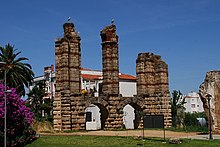San Lázaro Roman aqueduct
Appearance
Acueducto Romano San Lázaro | |
 | |
| Location | Mérida (Badajoz), Spain |
|---|---|
| Coordinates | 38°55′12″N 6°20′07″W / 38.920108°N 6.335347°W |
| Official name | San Lázaro Aqueduct |
| Type | Cultural |
| Criteria | iii, iv |
| Designated | 1993 (17th session) |
| Part of | Archaeological Ensemble of Mérida |
| Reference no. | 664-002 |
| Region | Europe and North America |
| Official name | Acueducto Romano San Lázaro |
| Type | Non-movable |
| Criteria | Monument |
| Designated | 13 December 1912 |
| Reference no. | RI-51-0000113 |
The San Lázaro Roman aqueduct is a Roman aqueduct in the Roman colonia of Emerita Augusta –present-day Mérida, Spain–, capital of the Roman province of Lusitania. It was built during the first century to supply water into the city.
It was declared Bien de Interés Cultural in 1912.[1] It is part of the Archaeological Ensemble of Mérida, which is one of the largest and most extensive archaeological sites in Spain and that was declared a World Heritage Site by UNESCO in 1993.
See also
[edit]- List of Bien de Interés Cultural in the Province of Badajoz
- Ancient Roman buildings and structures in Spain
- List of aqueducts in the Roman Empire
- List of Roman aqueducts by date
- Ancient Roman technology
- Roman engineering
References
[edit]- ^ Ruiz, Rita; Cruz, Linarejos; Rodríguez, Francisco Javier; Coronado, José María (May 2016). "Civil engineering heritage in Spain: public protection strategies". Proceedings of the Institution of Civil Engineers - Engineering History and Heritage. 169 (2): 84–94. doi:10.1680/jenhh.15.00005. ISSN 1757-9430.


